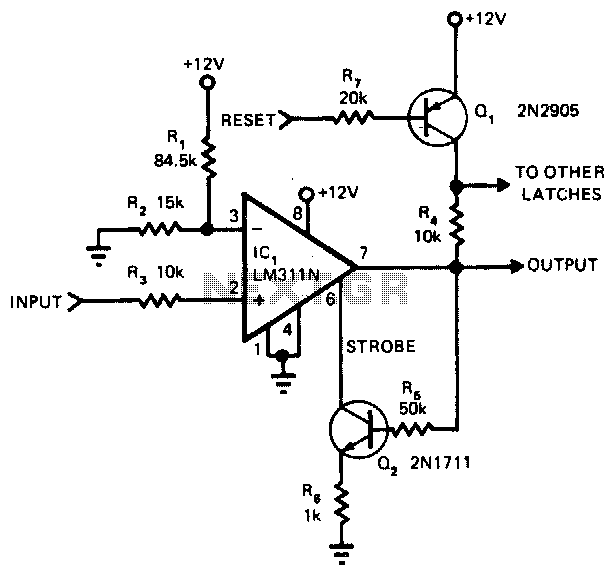
Comparator-latch

The main advantage of this circuit, in comparison to other comparators, is its capability to latch once the input surpasses a specified threshold level. When the input goes beyond this threshold, the output of the LM311N rises. This change activates the strobe input, which prevents the output from dropping low. A high voltage on the reset input will turn off Q1, thus disconnecting the supply voltage from the open collector output of the LM311N. When there is no supply to the strobe input, the latch condition is released, allowing the output to once again track the input variations. The LM311N is designed to function with a wide range of supply voltage levels, from dual ±15 V to a single 5 V level, ensuring compatibility with digital IC logic. If multiple latches are utilized with a shared reset, all pull-up resistors can be connected to the collector of Q1.
The circuit employs the LM311N comparator, which is a versatile device capable of operating in various configurations. The latching feature of this circuit is particularly beneficial in applications requiring stable output states after a threshold has been crossed, such as in level detection or signal conditioning. The output of the LM311N transitions from low to high when the input signal exceeds the predetermined threshold. This transition is crucial as it activates the strobe input, which effectively locks the output state at a high level, maintaining the output until the reset condition is triggered.
The reset mechanism is facilitated by Q1, a transistor that controls the power supply to the LM311N's output. When a high voltage is applied to the reset input, Q1 turns off, interrupting the power to the open collector output. This action releases the latch condition, allowing the LM311N to respond to subsequent changes in the input signal. The flexibility in supply voltage, ranging from ±15 V to 5 V, makes the LM311N suitable for integration in various digital systems, ensuring it can interface seamlessly with other digital logic components.
In scenarios where multiple latches are employed, the common reset feature simplifies the circuit design. By connecting all pull-up resistors to the collector of Q1, the circuit can maintain a coherent reset signal across all latches, enhancing reliability and reducing complexity. Overall, this circuit design provides a robust solution for applications requiring precise threshold detection and stable output states, making it a valuable component in electronic systems.The primary advantage of this circuit, when compared to other comparators, is its ability to latch after the input has reached a predetermined threshold level. When the input exceeds the threshold level, the LM311N output increases. This transition enables the strobe input, preventing the output from falling low. A high-level voltage on the reset input will tum off Q1, thereby removing the supply voltage from the open collector output of the LM311N.
With no supply to the strobe input, the latch condition is removed and the output is again allowed to follow the input excursions. The LM311N will operate with a wide variety of supply voltage levels, ranging from dual ± 15 V to a single 5 V level that provides compatibility with digital IC logic.
If more than one latch is used with a common reset, all the pull-up resistors may be connected to Q1"s collector. 🔗 External reference
The circuit employs the LM311N comparator, which is a versatile device capable of operating in various configurations. The latching feature of this circuit is particularly beneficial in applications requiring stable output states after a threshold has been crossed, such as in level detection or signal conditioning. The output of the LM311N transitions from low to high when the input signal exceeds the predetermined threshold. This transition is crucial as it activates the strobe input, which effectively locks the output state at a high level, maintaining the output until the reset condition is triggered.
The reset mechanism is facilitated by Q1, a transistor that controls the power supply to the LM311N's output. When a high voltage is applied to the reset input, Q1 turns off, interrupting the power to the open collector output. This action releases the latch condition, allowing the LM311N to respond to subsequent changes in the input signal. The flexibility in supply voltage, ranging from ±15 V to 5 V, makes the LM311N suitable for integration in various digital systems, ensuring it can interface seamlessly with other digital logic components.
In scenarios where multiple latches are employed, the common reset feature simplifies the circuit design. By connecting all pull-up resistors to the collector of Q1, the circuit can maintain a coherent reset signal across all latches, enhancing reliability and reducing complexity. Overall, this circuit design provides a robust solution for applications requiring precise threshold detection and stable output states, making it a valuable component in electronic systems.The primary advantage of this circuit, when compared to other comparators, is its ability to latch after the input has reached a predetermined threshold level. When the input exceeds the threshold level, the LM311N output increases. This transition enables the strobe input, preventing the output from falling low. A high-level voltage on the reset input will tum off Q1, thereby removing the supply voltage from the open collector output of the LM311N.
With no supply to the strobe input, the latch condition is removed and the output is again allowed to follow the input excursions. The LM311N will operate with a wide variety of supply voltage levels, ranging from dual ± 15 V to a single 5 V level that provides compatibility with digital IC logic.
If more than one latch is used with a common reset, all the pull-up resistors may be connected to Q1"s collector. 🔗 External reference